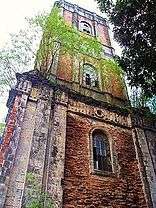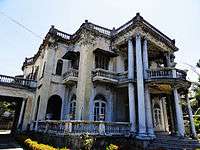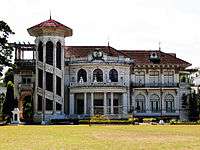Jaro, Iloilo City
| Jaro | |||||
|---|---|---|---|---|---|
| City District | |||||
| |||||
|
Nickname(s): "City Within a City" "The Mestizo District of Iloilo" "Seat of the Catholic Archbishopric of Jaro" "Seat of Catholicism and Protestantism" | |||||
.svg.png) Jaro Location in the Philippines | |||||
| Coordinates: 10°41′24″N 122°33′0″E / 10.69000°N 122.55000°E | |||||
| Country |
| ||||
| Region | Western Visayas (Region VI) | ||||
| Province | Iloilo | ||||
| City | Iloilo City | ||||
| Established | 1886 (City) | ||||
| Incorporated | July 16, 1937 (Iloilo City) | ||||
| Government | |||||
| • Mayor | Jed Patrick Mabilog (Liberal) (Mayor of Iloilo City) | ||||
| Area | |||||
| • City District | 27 km2 (10 sq mi) | ||||
| Elevation | -2 to 6 m (-6.5 to 20 ft) | ||||
| Population | |||||
| • City District | 343,829 | ||||
| • Metro | 1,235,650 | ||||
| Demonym(s) | Jaroeño/Jareño, Taga-Jaro, Salognon | ||||
| Time zone | PST (UTC+8) | ||||
| Patron Saint | Nuestra Señora de la Candelaria (Our Lady of Candles) (Catholic Patron Saint) | ||||
| Feast Day | February 2 | ||||
| Website |
www | ||||
Jaro is one of the seven districts of Iloilo City, in the province of Iloilo, on the island of Panay, in the Western Visayas region of the Philippines. It is a former separate city that lends its name to the Roman Catholic Archdiocese of Jaro, which covers the provinces of Iloilo and Guimaras and is the metropolitan see of Western Visayas and Negros Occidental province in Negros Island Region, before it merged with Iloilo City when it was incorporated during the American administration in the Philippines. Jaro is the largest of all districts of Iloilo City. The district of La Paz was a former part of Jaro before it became separated.
The Jaro annual Catholic Feast of Nuestra Señora de la Candelaria (Our Lady of the Candles), the patron of the whole Western Visayas and Negros Occidental in Negros Island Region, which is held every February 2 is well known in the Philippines. The town of Jaro is considered as the Mestizo Town in Iloilo with numbers of prominent Spanish Filipino families came from the area.
Jaro is the cradle of Christian faiths with Roman Catholic and Protestant institutions established and founded in the area. The Spanish Catholics established institutions like the Jaro Cathedral and the Archdiocese of Jaro. With the coming of the American Protestants in the early 20th century, they established institutions like the Central Philippine University, the first Baptist and second American University in Asia, Iloilo Mission Hospital, the first Protestant hospital in the country and second American hospital in Asia. The Jaro Evangelical Church, the first Baptist Church in the Philippines; Jaro Adventist Center, the first Adventist Church in the country; and the Convention of Philippine Baptist Churches, the oldest Baptist churches organization in the Philippines were also established.
History
_Reception-Taft.jpg)
Its original name was Salog or Saro.[1] It was also referred to as "Ilaya" or "mountain/dry land" together with La Paz which was referred to as "Ilawod" or "sea/wet land".[2] It had been one of the richer areas of Iloilo City even during the Spanish colonial period (1521-1898) and probably the richest town of the entire colony. Historical artifacts indicate that it had once conducted trade with China and Siam (Thailand) due to its port along the navigable river that ran through the town. It was also the center of religious and economic power in the Visayas during the Spanish rule.
Jaro officially became a city in 1886. La Paz, Iloilo City was a part of Jaro until it became independent from Jaro and became a Town and incorporated into the City of Iloilo. It was later absorbed by the City of Iloilo along with the neighboring towns of Molo, Mandurriao, La Paz and Arevalo in the early 20th century when all economic activities were shifted to the port of Iloilo.
Located between Dungon Creek and the Jaro River, Jaro fulfills the ideal design for establishing communities during that era: a site between two rivers, with a church and plaza in the center, and homes of affluent families in the vicinity. The church is the famous Parish of Our Lady of Candles, also known as the Jaro Metropolitan Cathedral, the headquarters of the Archdiocese of Jaro and the site of a miraculous statue of the Virgin Mary, which is a statue that has been growing in size ever since its discovery. Legends also state that among misty days, the Virgin Mary had disappeared from its original nook near the apex of the cathedral and bathed her child in the stream that used to well-forth from Jaro Plaza or that in Moro incursions, the Virgin had assisted in frightening off the raiders. The Marian image was canonically crowned by Pope John Paul II during his visit in 1982.
The coming of the Americans in the early 20th century when the Philippines was ceded by Spain to the United States through the 1898 Treaty of Paris brought with them the Protestant religion and Iloilo is one of the first places where they came and started a mission in the Philippines. During the American occupation, the Philippine islands were divided to different Protestant missions and Western Visayas came to the jurisdiction of the Baptists. Baptist missionaries came although other Protestant sects came also especially the Presbyterians and they established numerous institutions. The Presbyterians established the Iloilo Mission Hospital in 1901, the first Protestant and American founded hospital in the country while the Baptists established the Jaro Evangelical Church, the first Baptist church in the islands, and the Central Philippine University in 1905, which was founded by William Valentine through a grant given by the American industrialist, oil magnate and philanthropist John D. Rockefeller as the first university in the City of Jaro and also the first Baptist founded and second American university in Asia.
Jaro's celebration of the Feast of Nuestra Señora de la Candelaria (Our Lady of the Candles) every February 2 is well known in the Philippines. The fiesta features pageantry with a fiesta queen from one of the prominent Spanish Filipino families of the place, and a cockfight at the Iloilo Coliseum, where cockfighting aficionados from all over the Philippines converge.[3]
The district is notable for its large amount of nineteenth-century architecture. Straddling the main plaza is the antique Jaro Cathedral and the Palasyo, the Archbishop's residence. Early 20th century colonial American architecture could be found also in American established institutions and structures especially on the main campus of Central Philippine University; the Jaro Evangelical Church, the first Baptist church in the Philippines; and the Jaro City Hall.
Majority of the mestizo families from Iloilo came from this town, because it was a center and main port during Spanish period and many Spanish traders married natives and settled on the island.
Population
Jaro holds a high-concentration of Filipino-Mestizos and hosts many ancestral mansions of old Visayan families (of Mestizo descent). Family mansions such as those owned by the Lopez, Montinolla, Sanson, Luzariagga, De la Rama etc. families line the streets of this historic district. The French traveler Gabriel Lafond de Lurcy wrote of the place as such in his travelogues.
Haro is much bigger in size than Iloilo; it is a rich town, of mestizos who own great fortunes… the people of Haro are more civilized than those of the other neighboring towns (Molo and Iloilo). The color of their skin is whiter, consequence of a great mixture of European blood; and Spanish is spoken better there than in any place in the colony, the Capital excepted; the women are very beautiful and I can give assurance of this, having had the pleasure of being amongst them, that they have grace and figure and the features, which would call attention even in Europe. They show taste in their dress, which is rich and elegant and, like all mestizas, they show a lot of spirit.— [4]
Religious institutions
Besides the Archdiocese of Jaro, the district includes the headquarters of the Convention of Philippine Baptist Churches, the oldest Baptist churches union; the Jaro Adventist Center, the first organized Seventh-day Adventist church in the Philippines; as well as the first Baptist church in the Philippines, the Jaro Evangelical Church, founded in 1901; the first Baptist and second American university in Asia, the Central Philippine University, which was founded in 1905.
Schools
- University of Iloilo (founded 1947)
- St. Vincent Ferrer Seminary (Founded 1865 - the oldest institution of higher education in Western Visayas)
- Colegio de San Jose (Founded 1872)
- University of San Agustin- High School Campus (Founded 1904)
- Central Philippine University (Founded 1905)
- Iloilo Science and Technology University (Founded 1905)
- De Paul College
- Angelicum School Iloilo (Founded 1978)
- Pius XII Institute
- Philippine Science High School Western Visayas Campus (founded 1992)
Also found in the district is the St. Joseph Regional Seminary, in Cubay. It is a theology seminary, as St. Vincent Seminary is a juniorate and philosophy seminary.
Notable institutions

Jaro Belfry (Campanario de Jaro)
Built in 1744, the Campanario de Jaro is one of the few belfries in the country that stood apart from the church where it belonged. It has served both as a religious structure and as a military watch tower during the Spanish Colonial Period.[5][6] This three-storey tower, which stands 29 meters high,[6] is currently made mainly of bricks and hewn limestone blocks and follows the Baroque-style architecture. The Campanario has suffered destruction from earthquakes that struck the region. The first among these was on 17 July 1787 wherein it has caused major damage in the structure. It was later rebuilt in 1833 under the supervision of the Augustinian friar Fr. Jesse Alvarez.[5] Another earthquake sometime between 1833 and 1881 however caused damages once again to the belfry, which was later restored by the first Bishop of Jaro Msgr. Mariano Cuartero in 1881.[6] The latest was on 25 January 1948, which only suffered minor damages. This was restored by the Iloilo city government and with the supervision of the National Historical Commission of the Philippines (formerly National Historical Institute) in the 1990s.[6][7] The Jaro Belfry was declared a National Historical Landmark in 1984.[8]
Jaro Plaza (Plaza Jaro)
Now called the Graciano Lopez Jaena Park, the Jaro Plaza is the center of activity in the district and is surrounded by the Jaro Cathedral, the Jaro Belfry, several old mansions, the former Jaro City Hall and the Archbishop’s Palace.
Jaro Cathedral (Catedral de Jaro)
Also known as the Church of St. Elizabeth of Hungary, the Jaro Cathedral was built in 1864, the year the district was named a diocese by Pope Pius IX, by order of Mariano Cuartero, first bishop of Jaro. Destroyed in the quake of January 1948 and restored by order of Jose Ma. Cuenco, first archbishop of Jaro in 1956. The cathedral’s style is basically Baroque, with the addition of Gothic elements over many renovations.This has been approved by the CBCP as the National Shrine of Our Lady of Candles.
Old Municipal Hall of Jaro (Municipio de Jaro)
Built in the 1930s, the old Jaro Municipal Hall is an Art Deco building designed by the Philippine National Artist for Architecture Juan Arellano and was embellished in the facade by an Italian sculptor Francesco Monti.[9] Currently the building is being used as the station of the Philippine National Police in Jaro district.[10] Plans are put in placed at present for the restoration and turning of the old Municipio de Jaro as the regional headquarters of National Museum of the Philippines.
Central Philippine University
Founded in 1905 through a grant given by the American industrialist, oil magnate and philanthropist John D. Rockefeller by the American Baptist missionary William Valentine, Central Philippine University is the First university in the City of Jaro and the first Baptist founded and second American university in Asia. The university has more than 40 buildings with some that dates back to the early 20th century. The university pioneered the work-study program which was later patterned and followed by other institutions; established the oldest student governing body in Asia, the Central Philippine University Republic; and has established the first nursing school in the Philippines, the Union Mission Hospital Training School for Nurses, the present day Central Philippine University College of Nursing and Allied Health Sciences. It has the biggest library collection in Western Visayas and it is also the first university in the Western Visayas that has been declared as a National Landmark/Historical Landmark by the National Historical Commission of the Philippines.
Other Heritage Structures
- Palacio Arzobispal (Archbishop's Palace), the residence of the Archbishop of Jaro. It is located southwest of the Jaro Cathedral and southeast of the Plaza Jaro.
- St. Vincent Ferrer Seminary, the first institution of higher learning in Western Visayas and Negros Island.
- The Lopez Mansion, also known as Nelly Garden is considered as the Queen of all mansions in Iloilo.
- Casa Montinola y Sanson, the house is reminiscent of the Gaston house in Silay City, Negros Occidental.
- Lizares Mansion, it was once the mansion of the Lizares family but was now turned into a school, Angelicum School Iloilo.
- Iloilo Mission Hospital, founded in 1901 as the Union Mission Hospital by the Protestant Presbyterian Americans is the first and oldest Protestant founded and American hospital in the Philippines. It has established the first Nursing school in the Philippines in 1906, the Union Mission Hospital Training School for Nurses which is the present Central Philippine University College of Nursing and Allied Health Sciences.
- University of San Agustin Basic Education Campus.
- Some ancestral houses in Jaro
 Nelly Garden
Nelly Garden Ledesma Mansion
Ledesma Mansion Lizares Mansion (now Angelicum School Iloilo)
Lizares Mansion (now Angelicum School Iloilo) Casa Mariquit
Casa Mariquit Sanson-Montinola Antillan House
Sanson-Montinola Antillan House
Notable residents
- Graciano Lopez Jaena - Philippine Revolution hero, editor, orator, journalist, writer of "La Solidaridad"
- Fernando López - former Vice-President of the Philippines and brother of Eugenio Lopez Sr.
- Eugenio Lopez Sr. - former Chairman of the Lopez Group of Companies
- Eugenio Lopez, Jr. - former Chairman Emeritus of ABS-CBN
- Eugenio Lopez III - present Chairman of ABS-CBN
- Raul M. Gonzalez - former Secretary of Justice of the Philippines
- Magdalena Jalandoni - Hiligaynon poet
- Jaime Cardinal Sin—former Archbishop of Jaro and Archbishop of Manila
- Gil Lopez Kabayao - renowned violinist
- Miriam Defensor-Santiago - member Philippine Senate
- Franklin Drilon - Senator
- Francis Jardeleza - Associate Justice, Supreme Court of the Philippines; former Solicitor General
References
- ↑ http://ilongo.weebly.com/iloilo-history-part-1.html
- ↑ History of Panay, Felix B. Regalado, Quintin B. Franco, Central Philippine University, 1973
- ↑ Salvilla, Rex S. (2003-01-30). "Iloilo Coliseum: World's biggest cockpit". Sun.Star Iloilo. Retrieved 2009-08-05.
- ↑ Quinze Ans de Voyage Autor de Monde Vol. II ( 1840). Retrieved 2014-7-25 from Institute for Research of Iloilo Official Website.
- 1 2 Orquinaza, Noreen Mae (March 24, 2014). "Jaro Belfry". IloiloNetPh. Retrieved 10 October 2014.
- 1 2 3 4 Rosal-Sumagaysay, Joy (June 22, 2007). "The Jaro Belfry — an Iloilo landmark". I Love Iloilo. Retrieved 10 October 2014.
- ↑ Joven, May (April 11, 2012). "P5M Jaro Belfry restoration set". Retrieved 11 October 2014.
- ↑ "Belfry of the Jaro Cathedral". National Registry of Historic Sites & structures in the Philippines. Retrieved 10 October 2014.
- ↑ "The UPV Main Building (Iloilo City Campus) by Juan Arellano". I Love Iloilo. 23 March 2007. Retrieved 14 December 2014.
- ↑ "Jaro Police Station 3 - About Us". Jaro Police Station 3. Retrieved 14 December 2014.
External links
| Wikimedia Commons has media related to Jaro, Iloilo City. |
